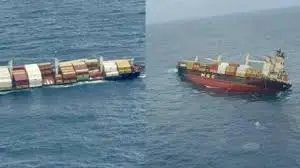Containers of capsized ship drift to Kerala coast: What we know about the oil spill risk, and preparedness to contain it

The recent maritime incident off the coast of Kerala has sparked considerable concern among environmentalists, authorities, and coastal communities. A large container ship, which capsized approximately 38 nautical miles southwest of Kochi, has caused several of its containers and hazardous cargo to drift toward the Kerala shoreline. This event raises pressing questions about the potential environmental risks, particularly the threat of oil spills, and the readiness of authorities to manage the crisis effectively.
The Incident at a Glance
On May 25, 2025, the Liberian-flagged container vessel MSC ELSA 3 met with disaster while en route from Vizhinjam to Kochi. The ship was carrying a total of 640 containers, including 13 containers loaded with hazardous materials and 12 containers containing calcium carbide, a chemical known to react dangerously with water. The vessel was also transporting significant quantities of fuel — approximately 84.44 tonnes of diesel and 367.1 tonnes of furnace oil.
Fortunately, the Indian Coast Guard and Navy swiftly coordinated a rescue operation that successfully evacuated all 24 crew members onboard. However, the capsizing of the vessel left a substantial amount of fuel and cargo vulnerable to entering the marine environment, triggering serious environmental and safety concerns.
Oil Spill Risks: A Threat to Marine and Coastal Ecosystems
One of the most immediate dangers posed by the incident is the risk of an oil spill. The combined fuel load of over 450 tonnes of diesel and furnace oil represents a significant threat to the fragile marine ecosystems surrounding the Kerala coast. Oil spills can have devastating effects on marine biodiversity, harming fish, seabirds, and other aquatic organisms. The toxic components of oil can contaminate water, impair breathing and feeding mechanisms in marine life, and disrupt entire food chains.
The oil slick also threatens to wash ashore, potentially affecting the coastal wetlands, mangroves, and sandy beaches that provide critical habitats for numerous species and serve as natural buffers against storms and coastal erosion. Beyond environmental damage, such spills can impact the livelihoods of fishing communities and the broader tourism sector, both of which depend heavily on healthy coastal waters.
Hazardous Cargo and Safety Concerns
In addition to the oil spill risk, the presence of hazardous cargo further complicates the situation. Calcium carbide containers are especially worrisome because calcium carbide reacts violently with water, producing acetylene gas — a flammable and potentially explosive substance. Should these containers rupture or come into contact with seawater, there is a heightened risk of fire or explosion.
Moreover, as the ship’s containers drift towards the coast, they pose a physical hazard to people along the shoreline. Several containers have already been reported washing ashore in coastal districts such as Kollam and Alappuzha. These floating containers, which can weigh several tons, are dangerous if handled improperly and may cause injuries to local residents or fishermen.
Preparedness and Response: Coordinated Efforts Underway
Recognizing the urgency of the situation, both state and central authorities have mobilized to mitigate the impact. The Kerala government, in collaboration with the Indian Coast Guard and Navy, has initiated a multi-pronged response strategy aimed at containing the oil spill, recovering drifting containers, and safeguarding coastal communities.
Oil Spill Containment
The Indian Coast Guard has deployed vessels and aircraft equipped with oil spill containment booms and dispersants. These efforts aim to limit the spread of oil slicks on the water’s surface and break down the oil into less harmful substances. The use of aerial surveillance helps track the movement of the slick and floating debris in real-time, enabling faster and more targeted interventions.
Recovery of Containers and Debris Management
Rapid response teams with specialized equipment such as cranes and excavators have been dispatched to key coastal areas to recover the containers that have already washed ashore. Proper disposal and management of cargo debris are critical to prevent further environmental contamination. Authorities are also setting up warning signs and barriers to keep people away from hazardous floating containers.
Public Safety Measures and Warnings
The state government and disaster management authorities have issued public advisories urging residents to avoid any contact with floating debris or containers. They have established dedicated helpline numbers for reporting sightings of drifting cargo, emphasizing the importance of public vigilance in the ongoing response. Communities in the high-risk districts of Alappuzha, Kollam, Ernakulam, and Thiruvananthapuram have been put on alert with instructions to maintain a safe distance from affected beaches and waterways.
Lessons and the Way Forward
This incident underscores the vulnerabilities of maritime transport along the Indian coast and highlights the importance of robust emergency preparedness and response mechanisms. The risks posed by such accidents are multifaceted — ranging from immediate physical dangers to long-term environmental degradation.
To strengthen resilience against future events, it is vital for authorities to invest in:
- Improved Monitoring: Enhanced satellite and coastal radar systems for early detection of drifting vessels and debris.
- Emergency Training: Regular drills and capacity-building for local disaster response teams and fishing communities.
- Environmental Safeguards: Strict regulations on the transport of hazardous cargo and improved ship inspection protocols.
- Community Awareness: Continuous public education campaigns on maritime safety and environmental conservation.
Conclusion
The drifting containers from the capsized MSC ELSA 3 represent a complex environmental and safety challenge for Kerala’s coast. While the rescue of all crew members was a success, the potential impact of oil spills and hazardous cargo remains a significant concern. Through coordinated containment efforts, public cooperation, and vigilant monitoring, authorities are working tirelessly to protect marine life, coastal ecosystems, and the safety of local populations.
The incident serves as a reminder of the delicate balance between human activities and the natural environment, and the need for ongoing vigilance, preparedness, and sustainable maritime practices to safeguard India’s precious coastline.






